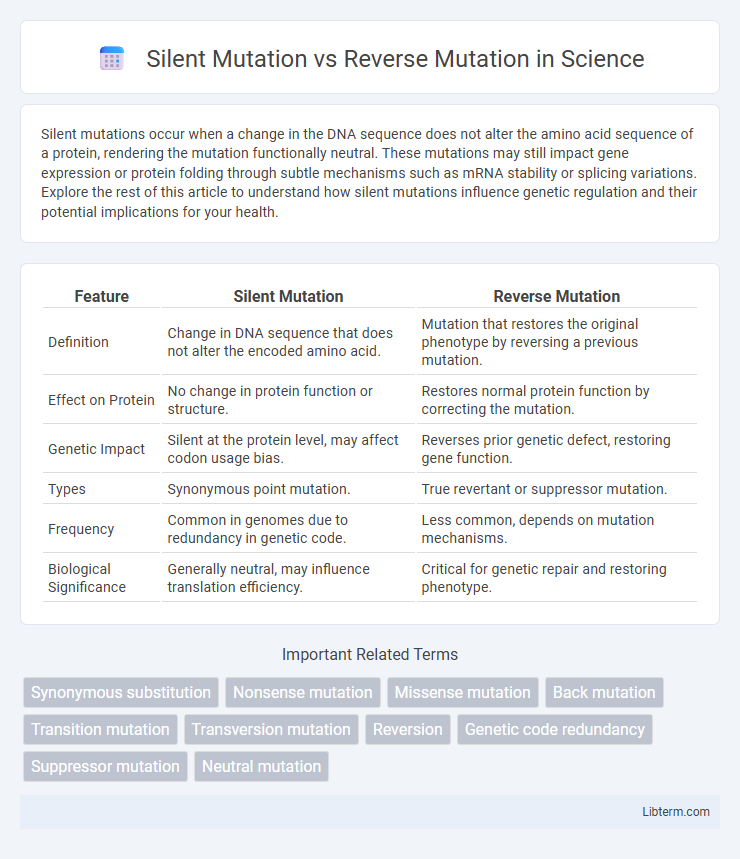Silent mutations occur when a change in the DNA sequence does not alter the amino acid sequence of a protein, rendering the mutation functionally neutral. These mutations may still impact gene expression or protein folding through subtle mechanisms such as mRNA stability or splicing variations. Explore the rest of this article to understand how silent mutations influence genetic regulation and their potential implications for your health.
Table of Comparison
| Feature | Silent Mutation | Reverse Mutation |
|---|---|---|
| Definition | Change in DNA sequence that does not alter the encoded amino acid. | Mutation that restores the original phenotype by reversing a previous mutation. |
| Effect on Protein | No change in protein function or structure. | Restores normal protein function by correcting the mutation. |
| Genetic Impact | Silent at the protein level, may affect codon usage bias. | Reverses prior genetic defect, restoring gene function. |
| Types | Synonymous point mutation. | True revertant or suppressor mutation. |
| Frequency | Common in genomes due to redundancy in genetic code. | Less common, depends on mutation mechanisms. |
| Biological Significance | Generally neutral, may influence translation efficiency. | Critical for genetic repair and restoring phenotype. |
Introduction to Genetic Mutations
Genetic mutations are changes in the DNA sequence that can alter gene function or expression, including silent mutations and reverse mutations. Silent mutations involve nucleotide changes that do not affect the amino acid sequence of a protein, preserving its function and phenotype. Reverse mutations restore the original DNA sequence or function, effectively reversing the effects of a previous mutation and reinstating the original phenotype.
Defining Silent Mutations
Silent mutations are changes in the nucleotide sequence of DNA that do not alter the amino acid sequence of the resulting protein due to the redundancy of the genetic code. These mutations typically occur in the third base of a codon and have no effect on protein function or phenotype. In contrast, reverse mutations restore the original nucleotide sequence or function after a previous mutation, often correcting a harmful effect caused by the initial mutation.
Understanding Reverse Mutations
Reverse mutations, also known as back mutations, restore the original nucleotide sequence altered by a previous mutation, effectively reversing the phenotypic change caused by the initial mutation. Unlike silent mutations, which involve nucleotide changes that do not alter the amino acid sequence or protein function, reverse mutations restore the wild-type function by precisely correcting the genetic defect. Understanding reverse mutations is crucial for studying genetic repair mechanisms and their impact on evolutionary processes and disease correction.
Key Differences Between Silent and Reverse Mutations
Silent mutations do not alter the amino acid sequence of a protein despite changes in the DNA codon, maintaining the original phenotype without functional impact. Reverse mutations restore the original nucleotide sequence or revert the mutated phenotype back to the wild-type, effectively reversing the effects of the initial mutation. Key differences include the functional outcome, where silent mutations are phenotypically neutral while reverse mutations actively restore lost gene function or phenotype.
Molecular Mechanisms Behind Silent Mutations
Silent mutations occur when a nucleotide change does not alter the amino acid sequence due to the redundancy of the genetic code, maintaining protein function despite DNA sequence variation. These mutations often arise from synonymous codons, where multiple codons code for the same amino acid, preserving translational fidelity during mRNA decoding. Reverse mutations restore the original nucleotide sequence or protein function by reverting the mutated gene back to its wild-type state, effectively counteracting the effects of forward mutations.
Mechanisms Involved in Reverse Mutations
Reverse mutations restore the original nucleotide sequence through precise molecular mechanisms such as base substitution, where an altered base is replaced with the original, and intragenic suppression involving a compensatory mutation within the same gene. Frameshift reversions correct insertion or deletion mutations by inserting or deleting nucleotides to restore the correct reading frame. These mechanisms contrast with silent mutations, which do not alter amino acid sequences despite nucleotide changes due to redundancy in the genetic code.
Biological Impacts of Silent Mutations
Silent mutations do not alter the amino acid sequence of a protein, often resulting in no immediate phenotypic change, yet they can influence mRNA stability, splicing, and translation efficiency. These subtle molecular impacts may affect gene expression and protein folding, contributing to complex biological outcomes and evolutionary variability. In contrast, reverse mutations restore the original gene sequence, potentially reversing altered phenotypes caused by a prior mutation.
Functional Consequences of Reverse Mutations
Reverse mutations restore the original function of a gene by correcting or compensating for the altered DNA sequence, thereby reversing the phenotypic effect caused by the initial mutation. Unlike silent mutations, which do not alter amino acid sequences or protein function, reverse mutations can reestablish normal protein activity and cellular processes. These functional consequences are critical for studying genetic diseases, as reverse mutations may facilitate the recovery of impaired gene function or inform targeted therapeutic strategies.
Clinical Relevance: Diagnosing Mutations
Silent mutations do not alter the amino acid sequence of proteins, often resulting in no phenotypic change and posing challenges for clinical diagnosis due to their subtle molecular footprint. Reverse mutations restore original gene function by correcting prior mutations, enabling precise identification of pathogenic variants important for targeted therapies. Accurate differentiation between silent and reverse mutations informs genetic testing strategies and guides effective patient management in inherited disorders.
Summary: Silent Mutation vs Reverse Mutation
Silent mutation involves a change in the nucleotide sequence that does not alter the amino acid sequence of a protein, maintaining its function despite genetic variation. Reverse mutation, also known as back mutation, restores the original nucleotide sequence, reversing the effects of a previous mutation and potentially recovering the original phenotype. Both mutation types play crucial roles in genetic stability and evolution, with silent mutations contributing to genetic diversity without phenotypic change and reverse mutations correcting deleterious mutations.
Silent Mutation Infographic

 libterm.com
libterm.com